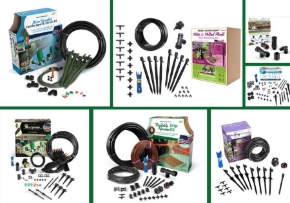July is Smart Irrigation Month, which reminds us that to be wise in how we irrigate our Landscapes and Gardens areas. Water is our most precious resource. It is very important to conserve our water during the hot summer months and when in drought areas of the country. Conserving your water will save you money as the price of water continues to rise.
Here are some smart ways to water your garden or landscape:
You don't need to water your lawn every day. During the summer months you only need to water every five to seven days. Your lawn only needs about one inch of water a week. You can buy a rain gauge to help keep track of how much water your grass is getting. The best time to water your lawn and plants is early in the morning or at night when the temperature is lower.
Mister Landscaper sells a timer that you can set to water your landscapes & garden beds when you want to. This will make smart watering very easy and avoid over or underwatering your plants. Mister Landscaper also sells a DIY easy to install low-flow Micro and Drip Irrigation kits that will use 50% to 70% less water then standerd irrigation. This will help keep the green in your garden as well as in your wallet! In the long run you will save water, time and money. Using mulch or graound cover also helps to retain moisture in the soil which means you have to water less overall.
For Smart Irrigation Month Mister Landscaper created a coloring book as a fun way to help teach kids about how to water wisely. You can download it by clicking this link.
Some other simple tips to save water and re-use it in the garden are...
If you are going to take a bath use the water after you are done to water your plants.
If you take a shower put a bucket in the shower to catch the water. When you are done use it to water your plants.
Rain Barrels, we have all heard of them. Getting one set up is not that hard, and you can use Micro and Drip Irrigation with them. Companies like Aqua Barrel make small pumps that cary the water in the barrel's to attached hoses for easy use. Check them out at http://www.aquabarrel.com
If you have any other smart watering tips you can join us on Facebook. We would love to hear from you.
http://www.facebook.com/MisterLandscaper
I want to wish all of you a smart watering day.














